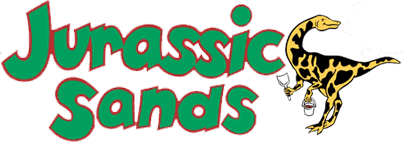The Benefits of Sensory Play for Early Childhood Development
Posted by Joe Sloan on
What is Sensory Play?
Sensory play is a great way to foster early childhood development through the power of play by engaging the senses. All you need is just a few simple items and you can create a sensory experience for your child. The items can include: 1) a container or bin 2) any toys or household items you want to include 3) varying sensory materials such as sand, beans, rice, cotton balls, soap, pudding, water, etc. Sensory play offers hands-on, interactive learning opportunities because children learn best through active engagement with the world around them.
Sensory play is a go-to activity for both parents and therapists because it offers various opportunities to work on all areas of development in differing ways. In this first video of our series discussing sensory play, Jurassic Sands wanted to offer an overview regarding the benefits of sensory play. In future videos, we will dive deeper into how to incorporate different types of play at a sensory bin/table, how to encourage speech and language skills while incorporating a sensory bin, and some example themes and strategies that you can try and explore with your child!
Sensory Play & Early Childhood Development
Areas of Early Childhood Development Sensory Play Can Target
Sensory play is a great tool to work on all areas of early childhood development, such as:
- Fine Motor
- Gross Motor
- Language
- Social & Emotional
- Cognitive
- Play Skill Development
- Sensory Development
Fine Motor Development
Sensory play can be a great way to work on your child's fine motor skills. Depending upon the sensory material you choose, your child can begin to grasp the material in various ways and progress up to using a pincer grasp with just two fingers. Scooping and dumping materials with a cup or spoon is also a great way to work on wrist rotation which helps prepare your child for what is physically needed to drink from an open cup, eat with utensils, do shape sorters, and complete age-appropriate puzzles. Your child can begin developing those fine motor skills as they naturally explore and play in the sensory bin.
Fine motor skills: scooping, dumping, manipulating various objects/toys, and grasping varying sized items.
Gross Motor Development
No matter where your child is at developmentally, you can always incorporate a sensory table or bin to develop their gross motor skills. For example, sensory play can benefit a child's gross motor development as they pull-to-stand at a sensory table, cruise along the table, squat down to pick a toy up, reach and stand up to grasp a toy, get weight through their legs, practice standing and sitting balance, develop core strength as they go in and out of midline, or walk to retrieve a toy in order to place it into the bin. It can also be used as a fun motivator for your child to practice walking or crawling toward the bin.
Gross motor skills: standing/sitting balance, core strength, squatting down and back up, pulling-to-stand, cruising, crawling, and walking.
Language Development
Sensory play is a great way to work on early childhood language development. Sensory play allows you to hold your child's attention while introducing new vocabulary words, showing your mouth as you make sounds, and acting out verbs with toys!
Language development: modeling language, imitation, emphasizing words, exposure to vocabulary words, and repetition.
Social-Emotional Development
Sensory play is a fun way to connect with your child. It allows you to get face-to-face with your child to share a positive experience together. It is a great opportunity to get joint attention with your child and then attune and react to each other’s facial expressions, emotions, and actions. Sensory tables are also a great way to allow children to practice parallel play with one another and begin to tune into what others are doing and feeling.
Social-emotional skills: connection, joint attention, emotions, attunement, facial expressions, reacting to others’ actions and feelings.
Cognitive Development
Depending on where your child is at developmentally, you can cater the activities to their cognitive level. For younger children, you are offering opportunities to learn more about cause and effect, object permanence, how cups and toys fit together, and the concepts of in/out by using containers. As children get older, you can incorporate all kinds of activities into the sensory bin which can include colors, shapes, letters, numbers, counting, sorting, and matching. You can also begin asking higher level “wh” questions.
Cognitive skills: building longer attention spans, cause and effect, in and out play, how things work and fit together, shapes, letters, site words, counting, numbers, colors, matching, sorting, answering “wh” questions.
Play Skill Development
Play skill can be targeted with a sensory bin by facilitating different types of play. Play is the most powerful tool for early childhood development.
Play skill development: solitary play, parallel play, and pretend play.
Sensory Development
A variety of sensory experiences from sight, to touch, to smell can help with a child's brain development and aid with feeding development.
Sensory development: exposure to new materials and textures.
This post was meant to be a broad overview of sensory play and how it can benefit a child's development. In future posts we will discuss different types of play and how to play with your child in a sensory bin. We also have plans to introduce different sensory table themes and techniques within a theme to focus on early language development!
Playspace Parenting
If you would like to follow more of Calley's work with parents and children be sure to check out PlaySpace Parenting.
Sensory Sands
Be sure to check out our sensory sands; perfect for any sensory bin or sensory table!
Share this post
0 comment
